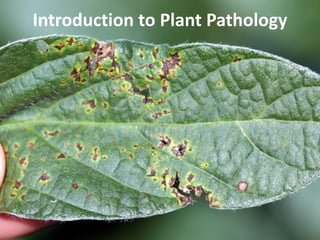
Introduction to Plant Pathology_0.pdf
- 1. Introduction to Plant Pathology
- 2. What is a plant disease? • A plant disease is any abnormal condition that alters the appearance or function of a plant. It is a physiological process that affects some or all plant functions. Disease may also reduce yield and quality of harvested product. • Disease is a process or a change that occurs over time. It does not occur instantly like injury.
- 3. What is a plant disease? • Visible effects of disease on plants are called symptoms. Any detectable changes in color, shape, and/or functions of the plant in response to a pathogen or disease-causing agent is a symptom. • Signs of plant disease are physical evidence of the pathogen, for example, fungal fruiting bodies, bacterial ooze, or nematode cysts. Signs also can help with plant disease identification.
- 4. What causes plant disease? • Infectious plant diseases are caused by living organisms that attack and obtain their nutrition from the plant they infect. The parasitic organism that causes a disease is a pathogen. Numerous fungi, bacteria, viruses, and nematodes are pathogens of corn and soybean in Iowa. • The plant invaded by the pathogen and serving as its food source is referred to as a host.
- 6. Role of the environment • A favorable environment is critically important for disease development – even the most susceptible plants exposed to huge amounts of a pathogen will not develop disease unless environmental conditions are favorable.
- 8. The Disease Triangle Soybean rust
- 9. Groups of plant pathogens - fungi • Vast majority are beneficial • Can cause plant, human, and livestock diseases • Most cannot be seen without a microscope • Lack chlorophyll • Composed of growing structure of delicate, threadlike filaments called hyphae • Reproduce by forming spores
- 10. Groups of plant pathogens - bacteria • Extremely small organism requiring microscope to be seen • Bacteria population can increase in number in short time period • Cells clump together in masses called colonies • Obtain food from dead or decaying organic matter or living tissue www.foodmate.net • Spread plant to plant by wind-driven rain • Gain entrance through natural plant openings or injuries
- 11. Groups of plant pathogens - viruses • Most familiar because they cause human and animal diseases such as influenza, polio, rabies, smallpox, and warts • Cause some destructive plant diseases • Measure only about one- millionth of an inch in size • Are not complete living systems • Survive only in living cells University of Florida • Transmitted by insects which are called vectors
- 12. Groups of plant pathogens - nematodes • Round, slender, threadlike worms • Some are parasites on animals, insects, fungi, other nematodes, and plants • Plant-parasitic nematodes have a stylet • Most live in the soil and feed in or on plant roots
- 13. Disease cycle Survival Inoculum produced Dispersal Infection Colonization Symptoms Production of survival structures Adapted from P. Vincelli, 2005
- 14. Fungi Bacteria Viruses Nematodes Survival Crop residue Soil Alt. hosts - Crop residue Soil Alt. hosts Insect vectors - - Alt. hosts Insect vectors Crop residue Soil - - Dispersal Wind Rain Insects Wind Rain Insects - - Insects Tillage Equipment Water run-off Infection Directly Wounds Insect feeding - Wounds Insect feeding - - Insect feeding Directly - - Comparison of disease cycles
- 15. Inoculum Source of inoculum varies for each disease • May be produced on residues left in the field • Present in the soil • Present in weeds or other crops in the area • Present in or on the seed • Present in soil sticking to equipment or tools • Carried by wind or water • Carried by insect vectors • Carried in by animals, birds, and people
- 16. Spread of inoculum Two ways 1. Plant placed in soil that contains a pathogen 2. Inoculum moves from its source to host plant Keith Weller, U.S. Department of Agriculture
- 17. Penetration of inoculum and infection • Infection occurs when a pathogen successfully enters a plant and grows, reproduces, and spreads within the plant • Pathogens enter a host through natural openings, wounds on plant surfaces, or by penetrating directly into the plant Penetration Mycelial growth Sporulation Pustule formation Spore germination Syngenta
- 18. Secondary cycles • Some diseases have only one cycle during the growing season (often root rots) • Some diseases develop secondary or repeating cycles during the growing season (often foliar diseases) • Number of cycles depends on the pathogen, susceptibility of the host, and environmental conditions
- 19. Pathogen survival Pathogens survive season to season in: • Soil • Crop residue • Weed or noncrop hosts • Seed or vegetative plant parts • Insects • Mild climates
- 20. Summary • Understanding the difference between a sign and a symptom is key in identifying a plant disease • A plant disease cannot develop if a susceptible host, pathogen, and favorable environment do not occur simultaneously • The major plant pathogens responsible for disease development in plants are fungi, bacteria, viruses, and nematodes • The disease cycle describes the interaction of the pathogen with the host